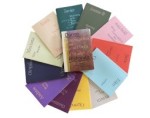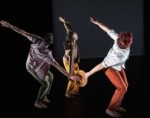
Access and Artistry: Part 3 - Audio Description
by Emilee Lord
In my interviews with Peter Trojic and Krishna Washburn, enough was said about Audio Description for dance that merited further dialogue, so I contacted Digital Accessibility Professionals and audio description users Walei Sabry and Michael Forzano. I hope what follows will encourage and enrich discussion among our readership around needs, best practices, and inclusive design.
Audio Description, defined by audio description pioneer Joel Synder, Ph.D., is "a verbal version of the visual—the visual is made verbal, and aural, and oral. Using words that are succinct, vivid, imaginative, and objective, audio description conveys the visual image that is not fully accessible, particularly for people who are blind or have low vision." AD has not been around that long. The practice history is fascinating, and because I don't have the space to cover it here, I encourage folks to read about it. After my previous interviews, I became curious about how AD happens for live performances and whether it works.
Forzano, who relies on Audio Description to see performances in New York, said that the process does not solve all accessibility concerns in the theater. First, there are not enough dates during show runs where AD is available, so there are fewer ticket options. He also says, "Anything that requires you to select a seat on a seating chart is generally not accessible with a screen reader." Out of the gate, there are limited options. When I spoke with Sabry, he recommended Theater Access NYC for help with scheduling and tickets for Broadway, although he acknowledged how many more live performances and venues there are in NYC outside of this.
Technology presents its own problems. Forzano says, "Besides being blind since birth, I'm hard of hearing and use cochlear implants. Ideally, I need amplification of the actual show dialog and AD to enjoy the show fully. There is no setup for this, as far as I know. I've yet to go to a show with good AD. In the last show, I left 20 minutes in because the device was not working. I left the theater, troubleshot, and found a device that worked, but by then, I was frustrated and had missed 30 minutes of the show. Before that, I went to a show where the device worked, but the static made it unintelligible."
Both Forzano and Sabry mention the GalaPro app used on Broadway. Forzano notes, "It is supposed to sync pre-recorded AD with the actual live show. I haven't used it personally, but I heard from other blind folks that it does not work well." Sabry, who uses the app, says, "They use AI, right? And they're actively listening to the actors and what they're saying. That's how they're syncing up with the audio description track, which is recorded. And they're also trained to correct themselves, so they will skip parts occasionally. They'll skip ahead, recognizing it's behind, and you could very clearly tell when it has skipped because it'll just cut itself off. That's a quality issue. The intention is great, but when you try to use too many tools, too much automation, too much technology, and now you're trying to use AI and all this cool new technology, the user is getting the short end of the stick."
Audio Descriptions' basic tenant is to describe only what is visual for the benefit of blind people and those with low vision. AD writers have established an objective language set without allowing themselves to add interpretation or metaphor to the work. Simile, in many cases, might seem to augment the image, but some writers would argue that it is still too subjective. While the quality of writing varies across the board, these standards have primarily operated well in television and film. "It's very, very matter of fact." says Sabry, "Not very engaging, in my opinion. Historically, it also had other problems with boundaries around things like describing race, which it didn't do. When not told, I could watch the whole movie and not know. And unfortunately, when they did start describing race, they only described race when it was a person of color. If you're automatically assuming that they're white, unless told otherwise, that makes the default race white. So that's problematic." When asked if this is still the norm for AD, he said, "I think I notice more and more descriptions of race, sexuality, gender identity, and sexual scenes, which I am thrilled to hear because when you censor something that isn't censored for the sighted audience members, it infantilizes me."
Quality and accuracy are essential to write in a way that doesn't remove anything a sighted person would experience. I spoke with a friend and AD user a while back about their time at a show where everyone laughed, and they had no idea why. Something was lost there. Was it in writing? Was it an issue of volume or timing of delivery? These questions point to the need for those writing and voicing AD to consult those who are blind and have low vision about the quality of experience and adjust according to their feedback. AD can be an art form in and of itself, but the writer’s ego needs to stay gently out of the way of the work's purpose.
After my conversation with Washburn, I was especially curious about AD for dance. I heard much about how objective Audio Description fails for dance because the form is largely about the translation of movement into meaning and emotion. If you're not interpreting it, you're not getting much out of it. Sabry said he was lost when he first started listening to AD for dance. Merely describing the movement of a body or where they move to doesn't engage the kinesthetic mirror, the physical knowledge in the viewer of a body in motion. Sabry said, "Dance is so visual and not verbal, and it's not always story based, right? In a plot, one action leads to another, creating predictability that we can follow. And dance doesn't have that about it. Metaphor is key here. Interpretation is key here, and also meaning. What I liked about the Kinetic Light audio description I used is it had all of these different tracks for you to choose from. Some were traditional and objective, some were like a friend whispering in your ear, some were metaphorical, and others were spaced out not to overwhelm you with language."
Forzano said, "A lot of work must be done to create a stress-free and enjoyable audio description experience. It's great to see smaller theaters, specifically Playwrights Horizons, incorporating Audio Description into all of their shows and including touch tours as part of the experience. But beyond that, I just haven't seen much progress."
If there is so much great technology, so much intention, and so much knowledge now but so little progress, we must look at why. First, an 'uninterrupted' experience on the part of sighted patrons is prioritized above the needs of others. There are very few shows, like Dark Disabled Stories (referred to by both Forzano and Sabry), that have AD and ASL built into the work itself. Sabry suggested that including concerns of accessibility earlier in the process of making work would be a great place to start. He said, "I think in an ideal world, the audio describer and even the ASL interpreter should have access to the choreographers, dancers, and creators, right? Not just the fact that we can do it more consistently, but I think the quality of it will change, and the practice itself will change. If the creators are interested in doing it right and having it as part of their show, they might pass ideas to the audio describer, right?"
And this is where inclusive design shows up; by including accessibility in either the design or discovery phases. "The closer you bring it to the creators, the more chance there is to create something, not just access related, but maybe even artistic," Sabry says. And it will require the sighted audience to be open to change. "There's this emphasis on normalcy and not changing when you've been watching movies, TV, and theater all of your life in just one way. I think people have an aversion to a new format. And I think most people who express doubt can get through that hurdle. They don't want to put in the effort."
Forzano summed up his thoughts on this by saying, "Unfortunately, there are others in the blind community who are grateful for anything and will say the system works well enough for them, but when you ask for more details, they say that they are very familiar with the show or listened to the soundtrack in advance. I firmly believe that any blind person should be able to go to a show without prior knowledge and enjoy it as anyone else would."
*This multiple-person interview was edited, combined, and condensed for length and clarity
By Emilee Lord
July 6, 2023










